Kothari D.P., Nagrath I.J. Modern Power Systems Analysis
Подождите немного. Документ загружается.

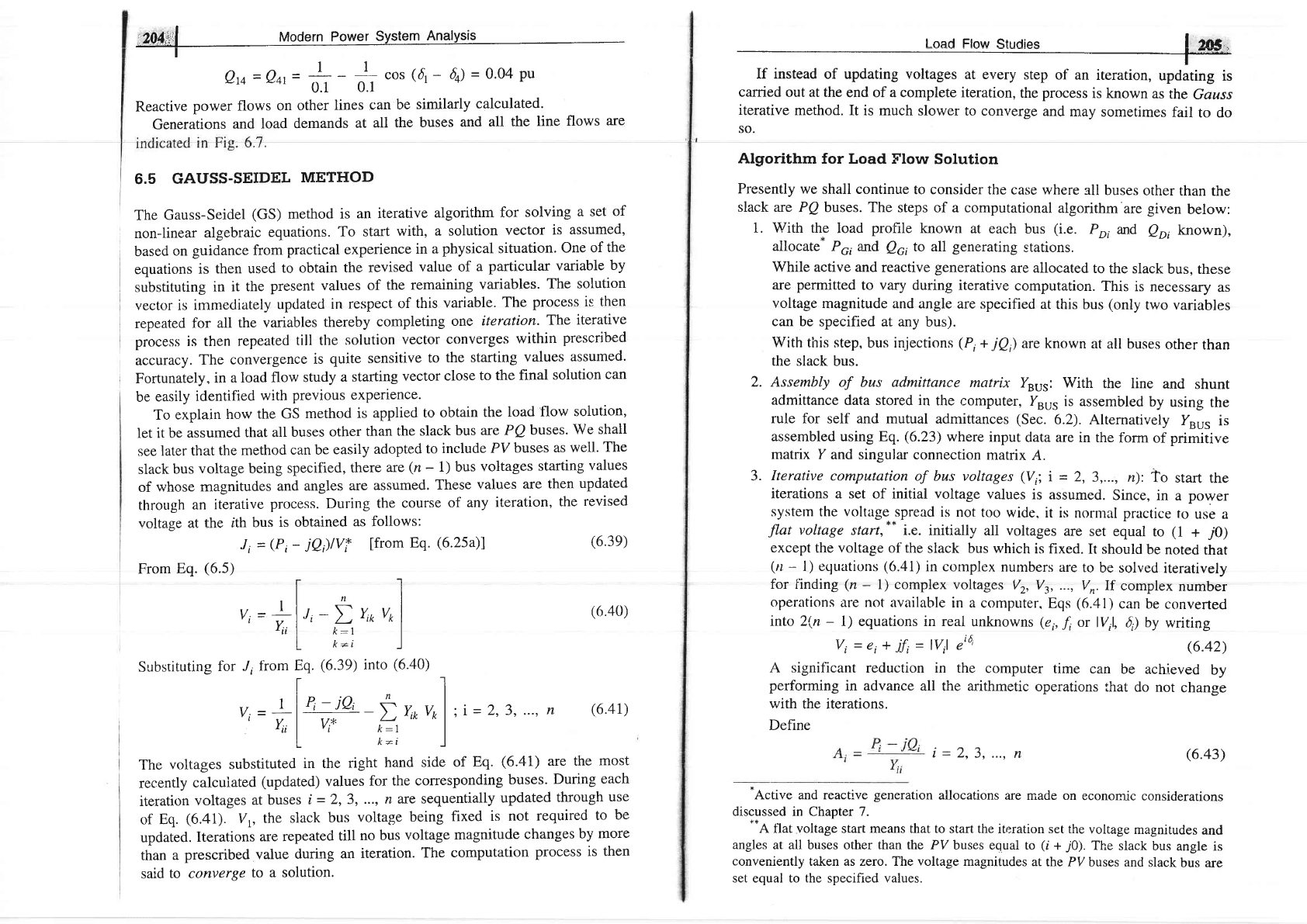
.2Oftril
Modern
Power
System
Analysis
I
eA
=
e+t
=
+
-
-1-
.o,
(6r
-
64)
=
0.04
pu
*+'
0.1
0.1
Reactive
power flows
on
other
lines
can
be
similarly
calculated.
Generations
and load
demands
at
all the
buses
and
all
the
line
flows
are
6.5
GAUSS.SEIDEL
METHOD
The
Gauss-Seidel
(GS)
method
is
an iterative
algorithm
for
solving
a set
of
non-linear
algebraic
equations.
To start
with,
a solution
vector
is
assumed,
based
on
guidance from
practical experience
in
a
physical situation.
One
of the
equations
is then
used
to obtain
the
revised
value of
a
particular
variable
by
substituting
in it
the
present
values
of the
remaining
variables.
The
solution
vector is
immecliately
updatecl
in respect
of
this
variable.
The
process
is then
repeated
for
all
the variables
thereby
completing
one
iteration.
The
iterative
process
is then
repeated
till the
solution
vector
converges
within
prescribed
accuracy.
The
convergence
is
quite sensitive
to
the starting
values
assumed'
Fortunately,
in a
load
flow
study
a
starting
vector
close
to the final
solution
can
be
easily
identified
with
previous experience.
To
explain
how
the
GS
method
is
applied
to
obtain
the
load
flow
solution,
let it be
assumed
that
all
buses
other
than
the slack
bus
are PB
buses.
We shall
see
later that
the
method
can be
easily
adopted
to
include
PV
buses
as well.
The
slack
bus
voltage being
specified,
there
are
(n
-
1) bus
voltages
starting
values
of
whose
magnitudes
and
angles
are
assumed.
These
values
are
then
updated
through
an iterative
process. During
the
course
of
any
iteration,
the
revised
voltage
at the
ith
bus
is obtained
as follows:
I en*.
carried
out at the
end of a complete iteration,
the
process
is
known as
the
Gauss
iterative
method.
It is much slower
to converge
and
may
sometimes
fail
to do
so.
Algorithm
for Load Flow
Solution
Presently
we
shall continue
to consider
the case where
all
buses
other
than
the
slack are
PQ buses. The
steps of a computational
algorithm'are
given
below:
1. With the
load
profile
known
at
each
bus
(i.e.
P^
and
0p;
known),
allocate*
Po, and.
Q5;
to all
generating
stations.
While
active and
reactive
generations
are allocated
to
the slack
bus, these
are
permitted
to
vary
during iterative
computation.
This
is necessary
as
voltage
magnitude and
angle are specified
at this bus
(only
two variables
can
be specified at any
bus).
With this step,
bus iniections
(P,
+
jQ)
are known
at
all buses
other
than
the slack
bus.
2. Assembly
of bus' admittance
matrix
rsus: with
the line
and
shunt
admittance data stored in
the computer,
Yru,
is
assembled
by
using
the
rule for self
and
mutual admittances
(Sec.
6.2).
Alternatively
yru,
is
assembled using Eq.
(6.23)
where
input
data are
in the
form
of
primitive
matrix Y
and singular
connection
matrix
A.
3.
Iterative
computation
of bus voltages
(V;;
L
=
2,
3,..., n):
To
start
the
iterations a
set of initial
voltage
values
is assumed.
Since, in
a
power
system
the
voltage
spread
is not
too wide.
it is
normal practice
ro
use a
flat
voltage
start,** i... initialiy
ali voltages
are
set equal
to
(r
+
70)
except
the
voltage
of the
slack bus which
is fixed.
It should
be
noted
that
(n
-
l) equations
(6.41)
in cornplex
numbers
are
to
be solved
iteratively
for findin1
@
-
1) complex voltages
V2,
V3, ...,
V,. If
complex
number
operations
zlre Dot available
in a
computer.
Eqs
(6.41)
can
be converted
rnto 2(n
-
1) equations in real
unknowns
(ei,
fr
or
lV,l,
5)
by
writing
Vr
=
€i +
ifi
=
lV,l ei6'
(6.42)
A significant
reduction in the
computer
time
can
be achieved
by
performing
in advance
all the arithmetic
operations
that
do
not
change
with
the iterations.
Define
i
=
2,3,
...,
ft (6.43)
'Active
and reactive
generation
allocations
are made on
econorfc
considerations
discussed in Chapter 7.
.*A
flat
voltage
start means that to start the
iteration set the
voltage
magnitudes
and
angles
at all buses other than the PV
buses equal to
(i
+
l0).
The slack
bus
angle is
conveniently
taken as zero. The
voltage
magnitudes
at
the PV buses
and
slack
bus
are
set equal to the specified values.
J,
=
(P,
-
jQ)lvi
[from
Eq.
(6.25a)]
From
Eq.
(6.5)
,[
I
v,=*lL,_
fv,ovol
,,'
L
T:i
I
Substituting
fbr
J, from
Eq.
(6.39)
into
(6.40)
t^
.
,
-l
v,
=
*l
'':jq
-
t
Yit' vr'
l
"
=
2' 3""'
n
Y"
I
vr*
ilt
I
I
k*t
I
(6.3e)
(6.40)
(6.4r)
The
voltages substituted
in the
right
hand
side
of
Eq.
(6.41)
are the
most
recently
calcuiated
(updated)
values
for
the
corresponding
buses.
During
each
iteration
voltages
at buses
i
=
2,3,
..., n
are sequentially
updated
through
use
of
Eq.
(6.41).
Vr,
the slack
bus
voltage
being
fixed
is not
required
to be
updated.
Iterations
are repeated
till
no
bus
voltage
magnitude
changes
by
more
than
a
prescribed
value
during
an
iteration.
The
computation
process
is then
said
to converge
to
a solution.
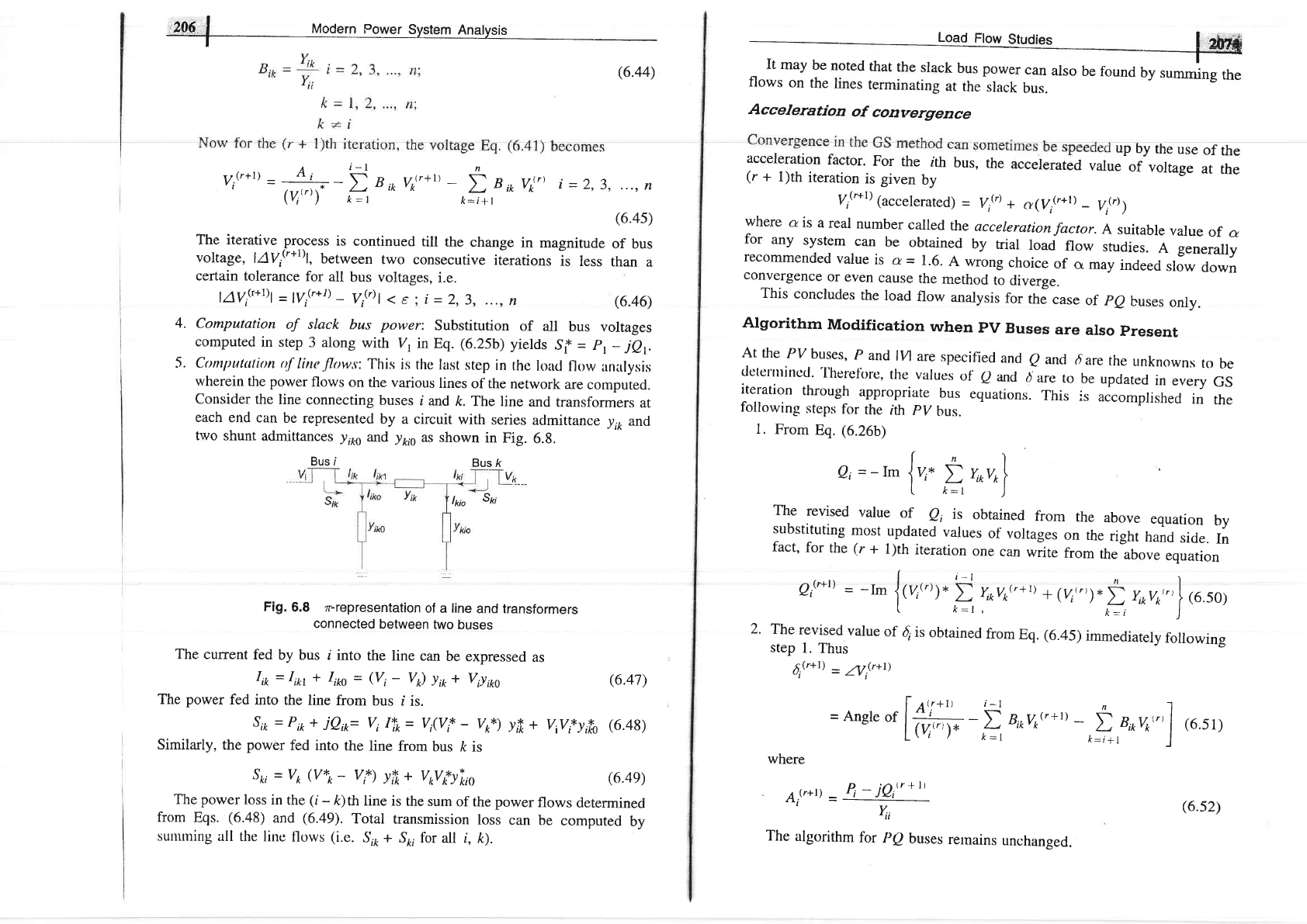
206
|
Modern
power
Svstem
Anatvsis
(6.44)
I*rl.d
flows
on
the
lines
terminating
at
the
slack
bus.
Acceleration
of
convergence
acceleration
factor.
For
the
tth
(r
+
l)th
iteration
is given
by
up
by
the
use
of
the
bus,
the
accelerated
value
of
voltage
at
the
y(r+r)
(accelerated)
=
V,Q'*
a(v.G+r)
-
V,Ql,
where
a is
a real
number
called
the
acceleration
factor.
A suitable
value
of
a
for
any
system
can
be
obtained
by
trial
load
flow
sfudies.
A generally
recommended
value
is
a
=
1.6.
A
wrong
choice
of
o.
may
indeed
slow
down
convergence
or
even
cause
the
method
to
diverge.
This
concludes
the
load
flow
analysis
for
thJ
case
of
pe
buses
onry.
Algorithm
Modification
when
pv
Buses
are
arso
present
At
the
PVbuses,
p
andrv]r
are
specified
and
e
ancr
dare
the
unknowns
to
be
detcnnincd.'l'hererirre,
the values
of
e
and
d
are
to
be
updated
in
every
GS
iteration
through
appropriate
bus
equations.
This
is
accomplished
in
the
following
steps
for
the
ith
pV
bus.
l.
From
Eq.
(6.26b)
f")
ei
=
-
Im
j
yr*
D,
y,ovof
L
ft:l
)
The
revised
value
of
ei
is
obtained
from
the
above
equation
by
substituting
most
updated
values
of
voltages
on
rhe
right
hand
side.
In
fact,
for
the
(.r
+
1)th
iteration
one
can
write
from
the
above
equation
I
g.(r+t)
=
-Ln
],r,',)
-
i
y,rv,,(,*t)
a
1y.r,1-
D
y,kvk,,,I
,u.ro,
I
Lr,
f!,
"
)
2'
The
revised
value
of
{.is
obtained
from
Eq. (6.45)
immediately
following
step
1.
Thus
6Q+r)
_
ay!+r)
=
Ansle
"t
fei]l-
-
i
Bovo(,+r)
-
D
B,ovo,,,l
(6.s1)
L
(t1''')*
,r:
r
k:,+r
J
where
.
^(r+t)-
P-i?t'rtt
r1.;
.=__
,u
_
6.52)
The
algorithm
for
pe
buses
remains
unchanged.
17(r+l) -
Ai
'S
- rt(,
n
vi'
-tB,ovo,,*t,-
f
r,ovl,,
i=2,3,...,n
(Vl")
ilt
k=irl
(6.4s)
The iterative
process
is continued
till the
change
in
magnitude
of
bus
voltage,
lav.('*r)|,
between
two
consecutive
iterations
is less
than
a
certain tolerance
for
all
bus
voltages,
i.e.
IAV.G*r)l
_
1y.t+r)
_
V,e)l <
6,
;
i
=
2,
3, ...,
n
4.
5.
computation
of slack
bus power:
substitution
of
all
bus
voltages
computed
in
step 3
along
with
V, in Eq.
(6.25b)
yields
Sf
=
pr-
jey
computtttion
ofline
.flows:
This
is thc
last
step in
thc
loacl
flow analysis
wherein
the
power
flows
on
the various
lines
of the
network
are
computed.
Consider
the
line
connecting
buses
i and k.
The line
and
transformers
at
each
end can
be represented
by a circuit
with
series
admittance y*
and
two
shunt
admittances
1l;ro
and
)no
as
shown
in
Fig.
6.8.
Bus i
Bus
k
(6.46)
(6.47)
(6.48)
(6.4e)
l*io
sm
Fig.
6.8 7i'-representation
of
a
line
and transformers
connected
between
two
buses
The current
fed
by
bus i
into
the line
can
be
expressed
as
Iit
=
Iitt +
Iirc
=
(Vi
-
V)
!it,+
V,y,oo
The
power
fed
into
the line
from
bus
i is.
S*
=
Pir*
jQiF
Vi
lfr=
Vi(Vf
-
Vr\
yft+
V!,*y,f,
Similarly,
the
power
fed into
the
line
from
bus
k is
Sri
=
Vk
(V*k-
Vf) yfo+
VoVfyi,l,
The
power
loss
in
the
(t
-
t)th
line
is the
sum
of
the
power
flows
determined
frorn
Eqs.
(6.48)
and
(6.49).
Total
transmission
loss
can
be
computed
by
sununing
all
the line
llows
(i.e.
5';a +
Sri fbr
all i,
/<).
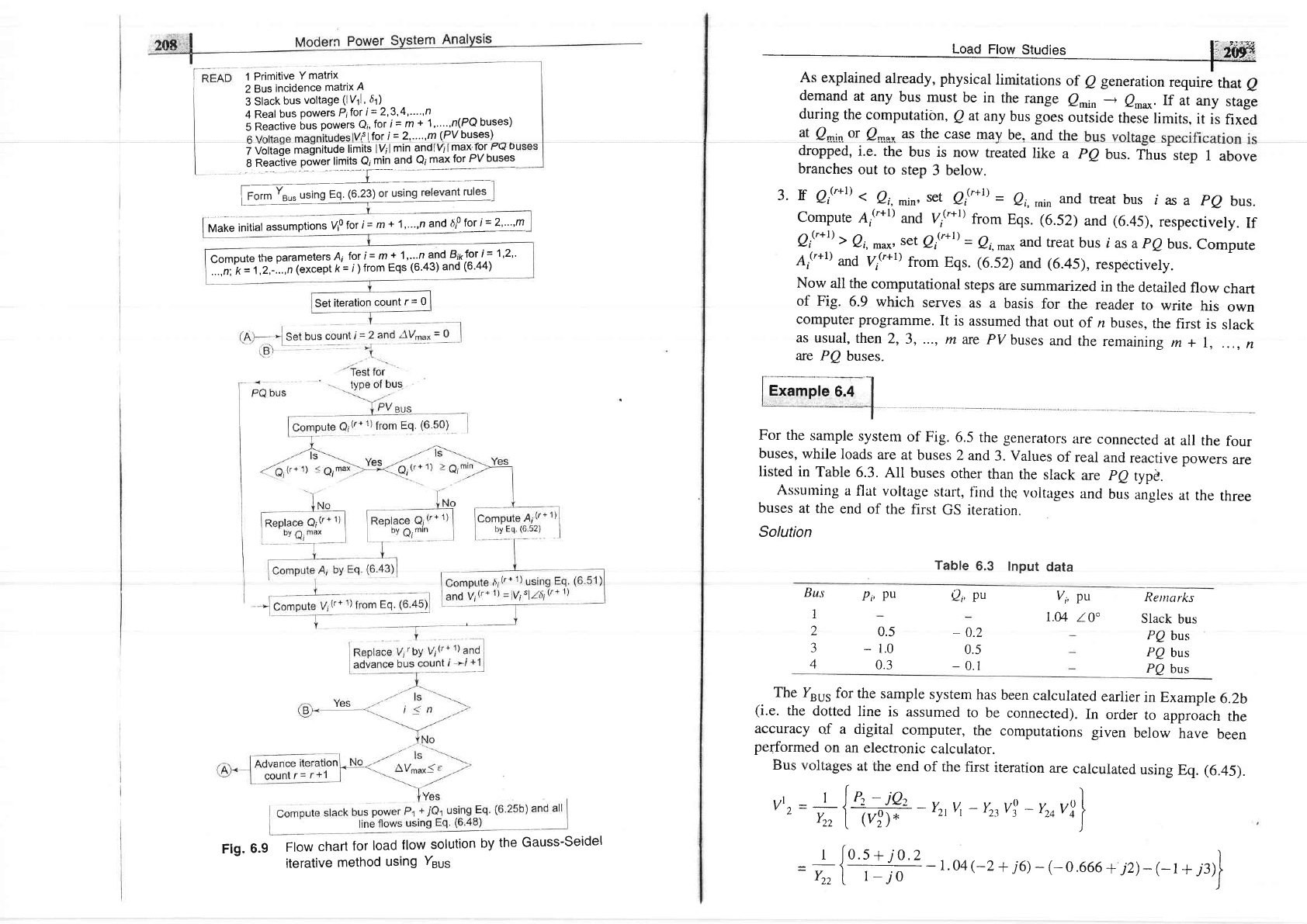
7
Voltage
magnitude
limits
I
Vr
I
min
and
I
Vi
I
max'lor
'-(J
o
b
n"u"iiu"
pow"t
limits Qi
min
and Q;
max
for
PV buses
Fig.6.9F|owchartforloadflowso|utionbytheGauss.Seide|
iterative
method
using
YBUS
l'fiffi
demand
at
any
bus
must
be
in
the
range
e^rn
-
e^u*.If
ai
any
stage
during
the
computatibn,
Q
at
any
bus goes
outside
ttreJe
timits,
it
is
fixed
At
Q^in
or
Q^o,
as
the case
may
be.
and
the
dropped,
i.e.
the
bus is
now
treated
like
a
pe
bus.
Thus
step
1
above
branches
out
to step
3 below.
3. ff
9.('+r)
a
0;,6;n,
set
e,Q*r)
-
er,r^n
and
treat
bus
f as
a
pe
bus.
compute
4-(r+1)
and
y(r+t)
from
Eqs.
(6.52)
and
(6.45),
respectively.
If
Otu..:,')
Qt,
^
,
set
O-(r+l)
=
ei,^*and
treat
bus
i as
a
pebus.
Compure
4.Q+r)
-6
y(r+l)
from
Eqs.
(6.52)
and
(6.45),
respecrively.
Now
all the
computational
steps
are
summarized
in the
detailed
flow
chart
of Fig.
6.9
which
serves
as
a
basis
for
the
reader
to
write
his
own
computer programme.
It
is
assumed
that
out
of
n buses,
the
first is
slack
as
usual,
then2,3,
...,
m are
PVbuses
and
the
remaining
m +
l,
...,
ft
are
PQ
buses.
For the
sample
system
of
Fig.
6.5
the generators
are
connected
at
all the
four
buses,
while
loads
are
at
buses
2
and
3.
Values
of
real
and
reactive
powers
are
listed
in Table
6.3.
All
buses
other
than
the
slack
are
pe
typd.
Assuming
a
flat voltage
start,
f)nd
the voltages
and
bus
angles
at
the
three
buses
at the
end
of the
first
GS iteration.
Solution
Table
6.3
lnput
data
Bus
1 Primitive
Y
matrix
2
Bus
incidence
matrix
A
3
Slack
bus
voltage
(lY1l, 61)
4 Real
bus
powers
Pifor
i=
2,3'4,""'n
5
Reactive
bus
powers
Qi,
for
I
=
m
+
1"
-{fO
buses)
Vf I
for
i
=
2,....,m
(PV
buses)
I
e
6.4
Exampl
Retnarks
Slack
bus
PQ
bus
Pp
bus
Pp
bus
The l"ur
for
the
sample
system
has
been
calculated
earlier
in
Example
6.2b
(i.e.
the
dotted
line
is
assumed
to
be
connected).
In
order
to
approach
the
accuracy
of
a digital
computer,
the
computations
given
below
have
been
performed
on an
electronic
calculator.
T)--- ---r-- - , ,i
-Dus
voltages
at
rne
eno
or tne llrst
rteratron
are
calculated
using
Eq.
(6.a5).
I
2
J
4
Pp
PU
0.5
-
1.0
0.3
0u
pu
-
0.2
0.5
-
0.1
Vt'
Pu
r.u
10"
vtz=+{W-Yztvt-Y"v!
-
'r^'iI
tg.
Yr,.
r.i"g
Eq.
(6.2
Make
initial
assumptions
Vio
for
I
=
m
+
1,"',n
and
O;0
for
i
=
2!:'m
Compute
the
parameters
A;
for
i
=
^
t
1,"n
.and
B;p'for
i
=
1'2"
-.;;
i:
1
,2,-'...,n
(except
k
=
i
)
from
Eqs
(6'43) and
(6'44)
Set
iteration
count
r
=
0
l
10.5+i0.2
')
-
----
1-'-
r
-'-
-
1.04
(-z+
j6)-
(-0.666
+
j2)_(_t
+
fll
-
Yzz
I
t
-iO
-'-'\
-
'
r-/
\
v'vvv
'
r!
|
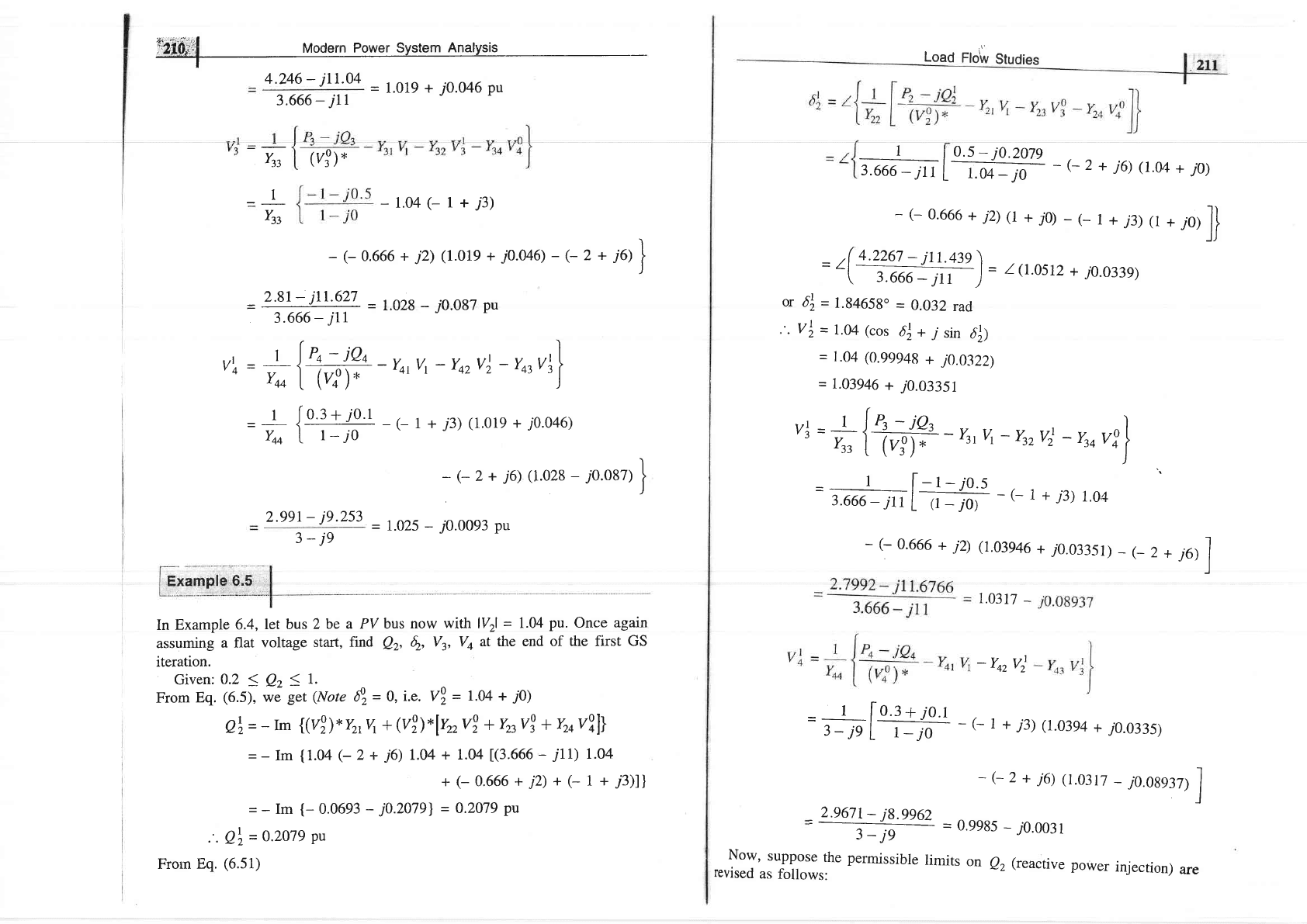
fei.fii,',1 Modern
Power System
Analysis
-
I
4.246
-
jrr.04
=
1.019
+
70.046
pu
3.666
-
jLr
(vl)
*
T#-frL+re
-
e
2
+
i6)
(to4
+
io)
-
(-
0.666
+
j2)
(t
+
70)
_
(_
1+
r)
j3)
(t.
io)
jl
=
t(
+'z^?e;t
-
itt'lzs
J
=
,
(r.rstz+
70.033e)
(
3.666_jtt
)-
or
612
=
1.84658o =
0.032
rad
.'.
v)
=
1.04
(cos
6)*
j
sin
dj)
=
1.04 (0.99948
+
j0.0322)
=
L03946
+
70.03351
,
(o
vl=-l-
j
'1-=iQt
-y.v.
-y_vt
_v ,,0I
'
t
=
1
114tr
-
Y"v'
-
Yszv;
-
Yrovl
,l
[-r_70.s-
3.666-in
L
,f;;
-
(-
t
+
i3)
1'04
-
(-
0.666
+
j2)
(1.03s46
+
70.03351)
_
(_
z
+
io)f
I
[0.3+ io.r
=
il
tf:;
-
(-
I
+
i3)
(1.03e4
+
70.0335)
-
(-
2
+
j6)
(r.03t7
_
yo.08e3z)
I
J
_
2.967r
_
j8.9962
3-ig
=0'9985-7O'0031
",,il1;,;llii,""rrirhe
permissibte
limits
on
ez
(reactive
power
injection)
are
1--
"
Ytt
_1
Yzt
-
r.04
(-
1
+
13)
Load
Flow
Studies
-
Yo,
vJ
I
-
(-
0.666
+
j2)
(1.019
+
;0.046)
-
(-
2
*
i6)
|
=
''!'-,-1"'.9?'
=
1.028
-
70.087
pu
3.666
-
jrr
I
-
(-
2
+
j6)
(1.028
-
jo.o87)
|
)
-
1.025
-
70.0093
pu
-
r^rr\l
19
+
70.046)
2.99r
-
j9.2s3
3-je
In
Example
6.4,let
bus
2 be
a PV bus
now
with
lV2l
=
1.04
pu.
Once
again
assuming
a flat
voltage
start,
find
Qz,
6.,
V3, V4
at the end
of the first GS
iteration.
Given:
0.2
<
Q,
<
l.
From
Eq.
(6.5),
ii
e",
(Note
fz=
0,
i.e. Vl
-
I.04 +
i0)
n,
=_
:
[J
.,:,,,:.
A,,i".
^r!:, J,
^.,,?,:
:
:;:
!::
^
+
(-
0.666
+
j2)
+
(-
I
+
i3)l
)
=
-
Im
{-
0.0693
-
j0.20791
-
0.2079
pu
'
O"
=
0'2079
Pu
From
Eq.
(6.51)
r.0317
-
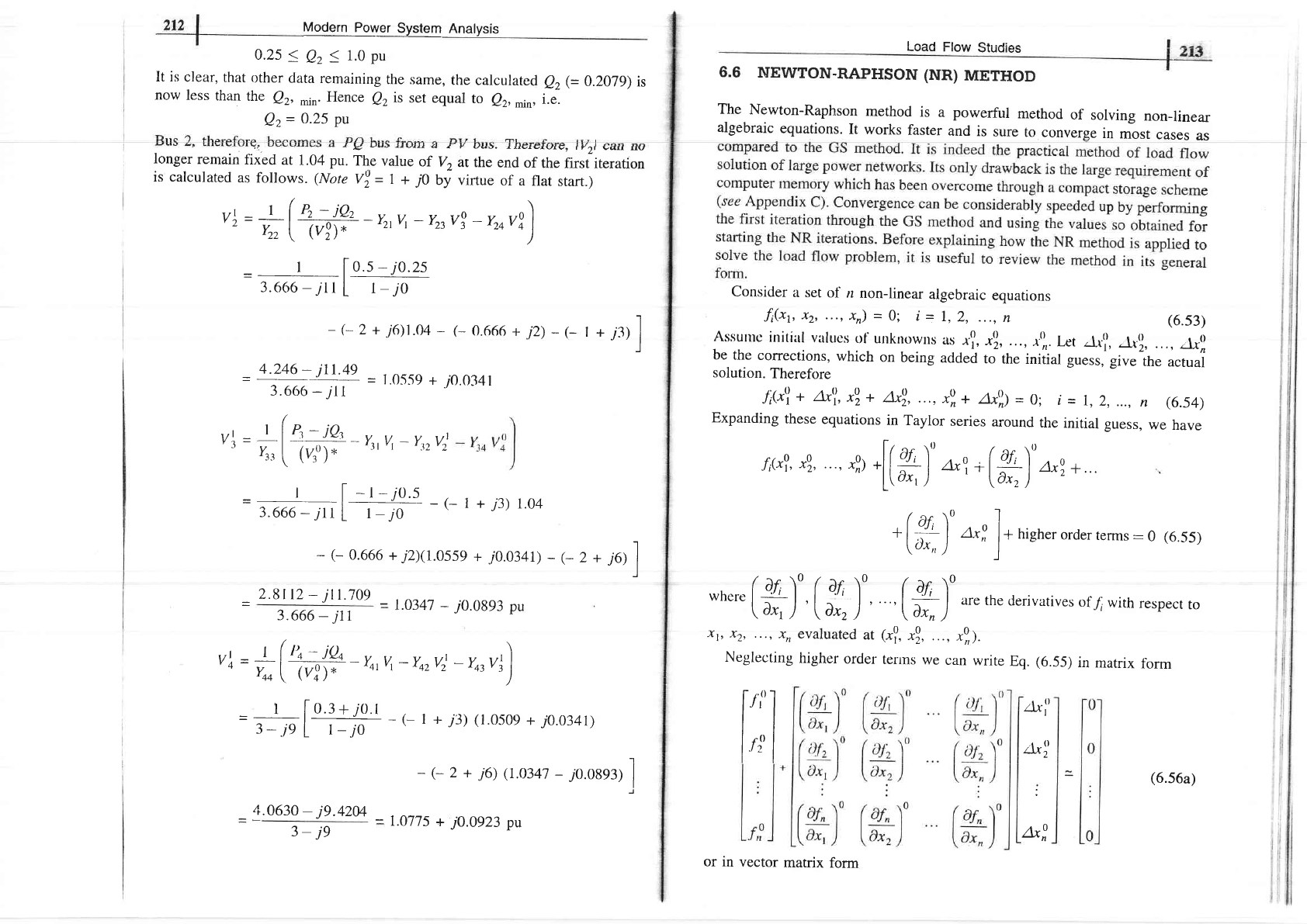
Modern
Power
System
Analysis
0.25
<
Qz
<
i.0
pu
It is
clear,
that
other
data
remaining
the
same,
the
calcul
ated
e2
(=
0.2079)
is
now less
than
the
Qz,
^in.Hence
e,
it
set equal
to
ez,
_in,
i.e.
Qz
=
0'25
Pu
a
-
p
---
uvrvrvrv,
tf
2t
vqLt llv
longer
remain
fiied
at
I.04 pu.
The
value
of
V,
ar the
end
of
the
first iteration
is calculated
as
follows.
(Note
VL
=
t
+
70
bf virrue
of
a flat
start.)
I aar{ Ela.., Or.,-r:^^
Lwqv
I tvyy
\)t,U(JlUli
6.6
NEWTON-RAPHSON
(NR)
METHOD
The
Newton-Raphson
method
is
a powerful
method
of
solving
non-linear
algebraic
equations.
It
works
faster
and
is
sure
to
converge
in
most
cases
as
vL
=
l-(
'r,
^!?,
-
yztvt
-
yztv?
- yrovl)
'z
Yr,
[
(Y3)-
-zt
|
-zr
J
-'"
")
_[o.s-jo.zs
3.666
-
jrl
L
t-r,
(*
2 +
i6)1.04
-
(-
0.666
+
.i2)
-
(-
-
4'246-
jlr-,?
=
t.05.59
+
io.o341
3.666
-
jtl
(
vj
=
: l':-:*
-.
Y,,v,
-
Y,,vJ
"
r,,
[
(Y,')'
[_t;u.t
_
(_
r +
j3)
toa
3.666-jrrL
r-;o
*
Consider
a
set of
n
non-linear
algebraic
equations
fi(\,
x2, ...,
xn)
=
0; i
=
I,2,
-..,
n
r+
i3)]
Assur.c
initial
vulucs
of u'know's
as
*l:
*'), ...,
r"r.
Let
J.r(1,
Jg,
...,
J_rl
be
the
corrections,
which
on
being
added
to
the
initial
guess,
givelhe
actual
solution.
Therefore
Jt@\+
futl,
*ur+
Axl,
..,,
x0,+
Axf;1
=
g;
i
=
1,2,
...,
n
(6.54)
Expanding
these
equations
in
Taylor
series
around
the
initial
guess,
we
have
f;(x01,
xor,
(6.ss)
Neglecting
higher
order
terins
we
can
write
Eq.
(6.55)
in
matrix
fbrm
(6.s3)
-
(-
0.666
+
j2X1.0s5e
+
70.0
341)
-
(-
2 +
j6)
]
,,r).[[*)' a*0,
.(#)'
Axt
+
/ ^- \0 I
*[
-l!t]
o-i
l*
n,rn-,
order
re,,ns
-
o
\ux,
)
l
whcrefg)',(
!f, )'. .f9
)'
\
d"r
/
(
Dr,
)
'
'
[
,",
,/
are
the
derivatives
of
It
with
respect
to
x1,
x2, ...,
x,
evaluated
at
(x!,
*1,
...,
*0,).
vL
=
;;W,#
-
Yo,v,
-
Yo,u|
-
v*v))
=
+,t"=#
-
(-
I +,r3)
(r'0s0e
+
i0'0341)
_
2.8t
t2
-
jn.709
3.666
-
jrr
/,.0630
-
j9
.42M
_
3-
je
1.0347
-
70.0893
pu
-1
-
(-
2 +
j6)
(r.034i
-
j0.08e3)
I
1.0775
+
j0.0923
pu
f''' l
I'rl
a'l'
Llxi
Ax:
or
in vector
matrix
form
(6.56a)
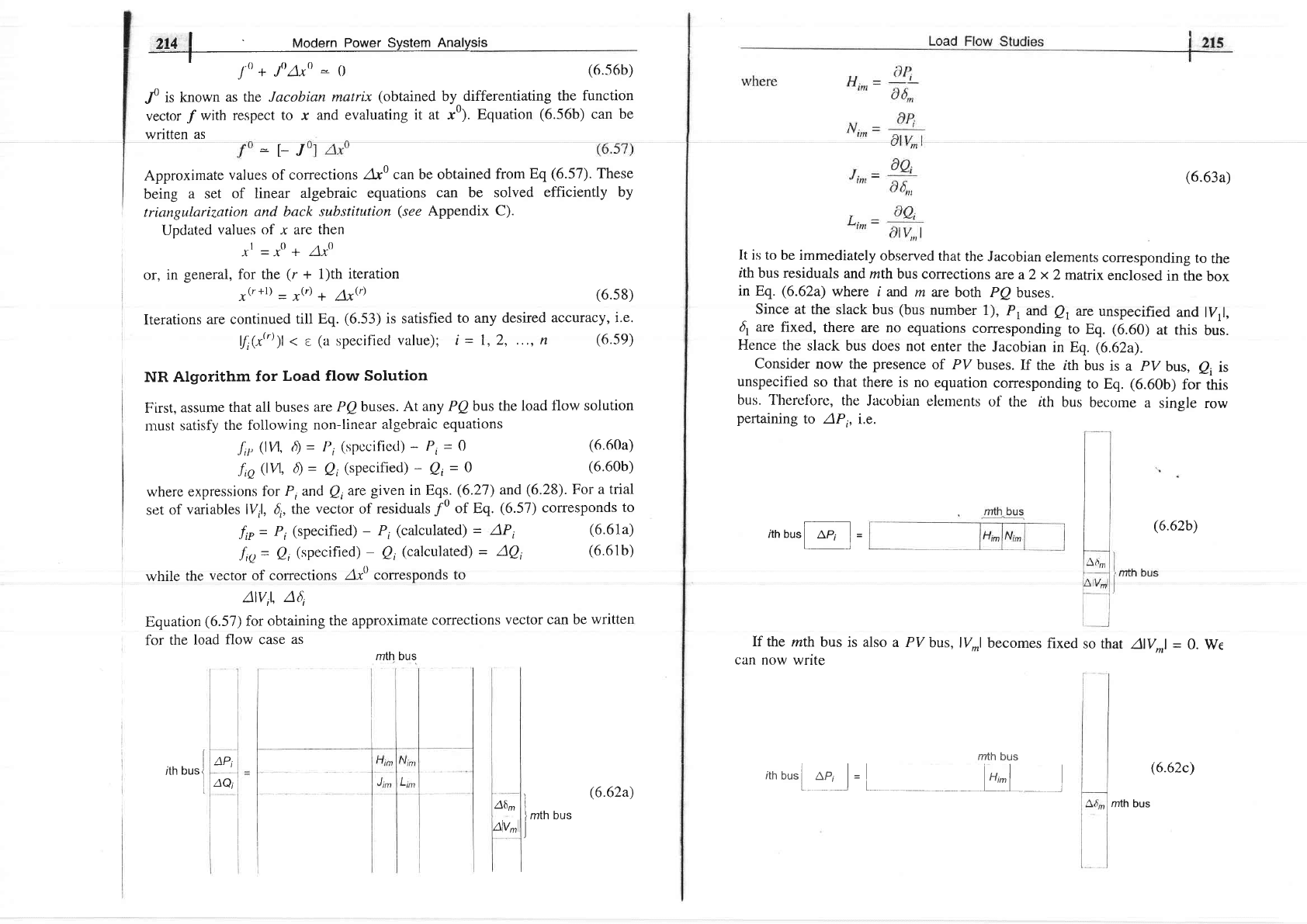
2ll I Modern Power Svstem Analvsis
-
l(,
+
.f,
A*,
*
0
(6.56b)
,f
is k,o*n
as the Jacobian
matrix
(obtained
by
differentiating
the
function
vector
f
with respect to x and
evaluating
it at r01.
Equation
(6.56b)
can be
written
as
:l_J
Approximate
values
of corrections
/-r0
can be obtained
from
Eq
(6.57).
These
being
a set
of linear
algebraic equations
can be solved
efficiently by
triangularization
and back substitution
(see
Appendix
C).
Updated
values of x are
then
tl
="0
+ AxI
or,
in
general, for the
(r
+ 1)th iteration
"(r+l)_r(r)+AxQ)
(6.s8)
Iterations
are continued
till Eq.
(6.53)
is
satisfied
to any desired
accuracy,
i.e.
(6.63a)
at
Alvml
=
0.
We
(6.62c)
mth
bus
First,
assume
that all buses
are
PQ buses.
At any
PQbus
the load
flow solution
rnust
satisfy
the following
non-linear
algebraic equations
lJiG")
)l
<
e
(a
specified
value); i
=
1,2,
..., n
NR Algorithm
for
Load
flow Solution
fip=
Pi
(specified)
-
Pi
(calculated)
=
APi
.fie=
Qi(specified)
-
Qi
@alculated)
-
AQi
(6.5e)
(6.60a)
(6.60b)
(6.61a)
(6.61b)
J'ip
(lV,
6)
=
I'i
(sPccificcl)
-
Pi
=
0
fiq
(1v1,
6)
=
Qi
(specified)
-
Qi
=
o
where
expressions
for
P, and
Q,
are
given
in Eqs.
(6.21)
and
(6.28).
For
a trial
set
of
variables
lV;1, 6;,
the
vector
of
residuals
/0
of Eq.
(6.57)
comesponds
to
while
the
vector
of
corrections
y'xo
corresponds
to
alvil,
a,i
Equation
(6.51)
for
obtaining
the approximate
corrections
vector can be
written
for
the
load
flow case
as
If
the mth
br-rs is also
a
can now
wnte
I
I
fth busl
,lPi
aQi
ithbusl
np,
l=l T:tT'
I
L-
---J t--
----
----rH''l
- l
46^
AlV^
I
(6.62a)
jmtn
ous
m
It is to
be immediately
observed
that
the Jacobian
elements
corresponding
to
the
ith
bus residuals
and
mth bus
corrections
are a 2
x
2
matrix
enclosed
in the
box
in Eq.
(6.62a)
where i
and m
Ne
both PQ
buses.
Since at the slackbus
(bus
number
l),
Prand
Qr
are
unspecified
and
lV,l,
Q
are fixed,
there
are no equations
corresponding
to Eq.
(6.60)
at this
bus.
Hence
the
slack bus does
not
enter
the
Jacobian
in Eq.
(6.62a).
consider now
the
presence
of PV
buses.
If
the ith
bus
is
a
pv
bus,
e,
is
unspecified
so
that there is
no
equation
corresponding
to Eq.
(6.60b)
for
this
bus.
Therclbrc,
the
Jacobian
eleurents
of the lth
bus become
a
sinele
row
pertaining
to AP,,
i.e.
rthbusF
l=
(6.62b)
PV
bus,
lVrl becomes
fixed
so th
mth
bus
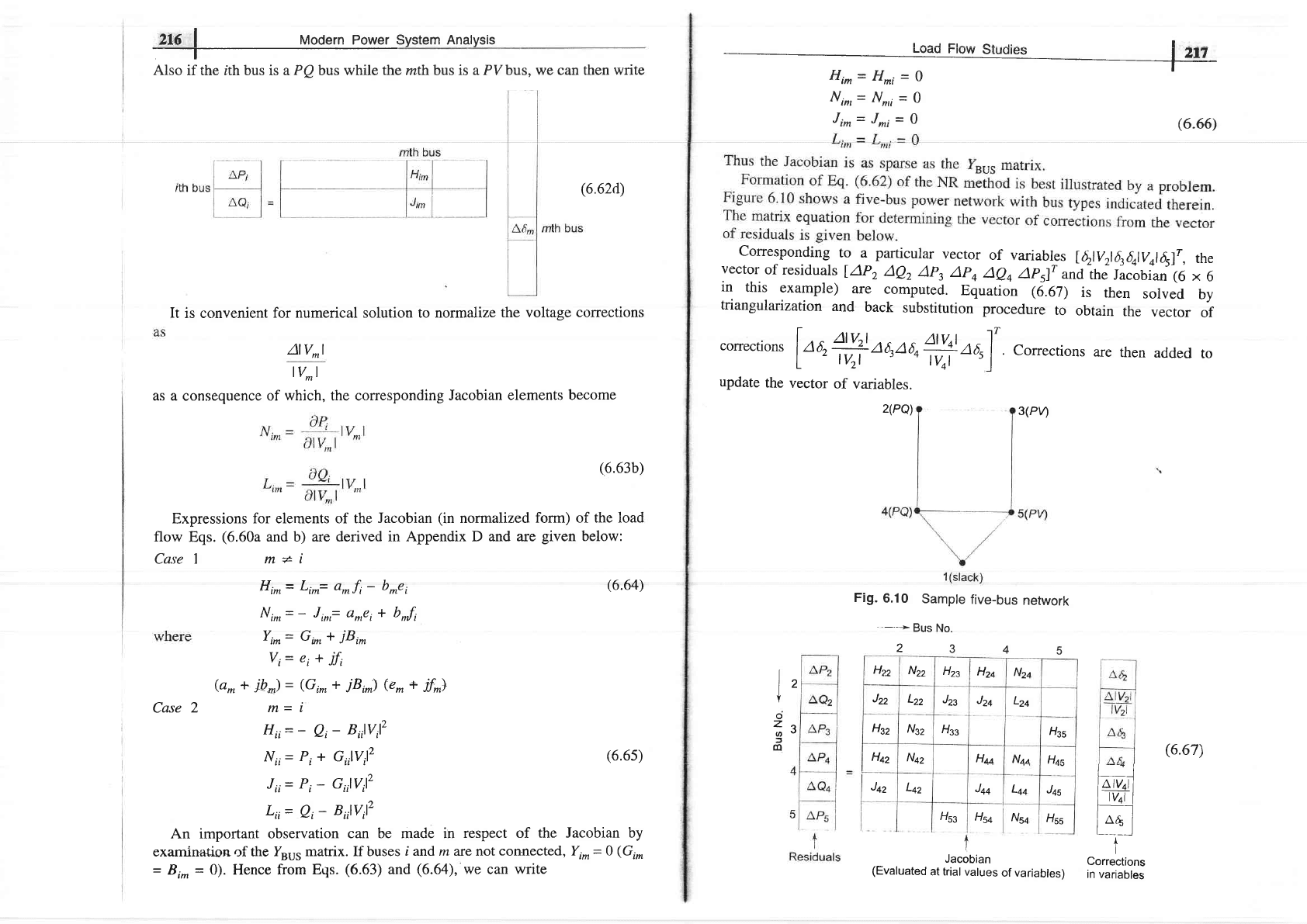
2L6
|
rtrodern Power System Analysis
Also
if the ith bus is a PQ bus while
the mth
bus
is a PV bus, we can then write
(6.62d)
It
is convenient
for numerical solution to normalize
the voltage
corrections
alv^l
lv^l
as a
consequence
of
which,
the corresponding
Jacobian
elements become
l
ztz
t
Ninr=
N^i
=
0
l,^=J^;=O
(6.66)
corresponding
to
a parricular
vecror
of
variables
tqlv2lq64lval6lr,
the
vector
of
residuars
[aP2
aez
ah
ap4
ae4
Apr],
and
the
Jacobian (6
x
6
in
this
example)
are
computed.
Equation
rc.an
is
then
solved
by
triangularization
and
back
substitution
procedure
to
obtain
the
vector
of
f nvt Atrl| 1r
corrections
I
oo,
#
oo1464
+
/,6r
l
.
corrections
are
then
added
to
L
lv2l
J
a
lVor
I
update
the
vector
of
variables.
2(Pa)
3(PVl
(6.63b)
Expressions
for elements of the
Jacobian
(in
normalized
form) of the load
flow
Eqs.
(6.60a
and b) are derived
in Appendix D and are
given
below:
Case I
mtl
H,^= Li^= a^fi
-
b*et
6.64)
Nr*=-
Jirr=
a.er+ bJt
Yi^=
G*
+
jB,*
Vi=
e, +
jf,
(a*
i
ib)
=
(Gi-
+
jBi*)
@*
+
jk\
case
2
I,,==t-
n,
-
Biirvirz
Mii=
Pi +
G,,lV,lz
IA A<\
\\J
' \'J,'
J
ti
=
Pi
-
Giilvil'
Li;=
Qi-
Biilvilz
An
important
observation
can be made in
respect of
the Jacobian by
examination of the
Y"u5 matrix. If buses
i and m are not
connected, Yi^= 0
(Gi^
=
Bi^
-
0). Hence from
Eqs.
(6.63)
and
(6.64),
we can write
I
l2
I
Y
o
f,z
J
c0
Fig.
6.10
Sample
five-bus
network
-'-*
Bus
No.
2345
Jacobian
(Evaluated
at
trial values
of variables)
[:_]
lalv4ll
l]ql-l
i_it_l
t
Corrections
in variables
Hzz
Nzz
Hzs
Hzn
Nza
Jzz
Lzz
Jzs
Jz+
Lz+
Hsz
Nsz
Hss
Hss
Hqz
Nn
Haa
Naz.
H+s
Jqz
Lqz
Jcc
Lu
J+s
Hss
H5a
Nsq
Hss
t
(6.67)
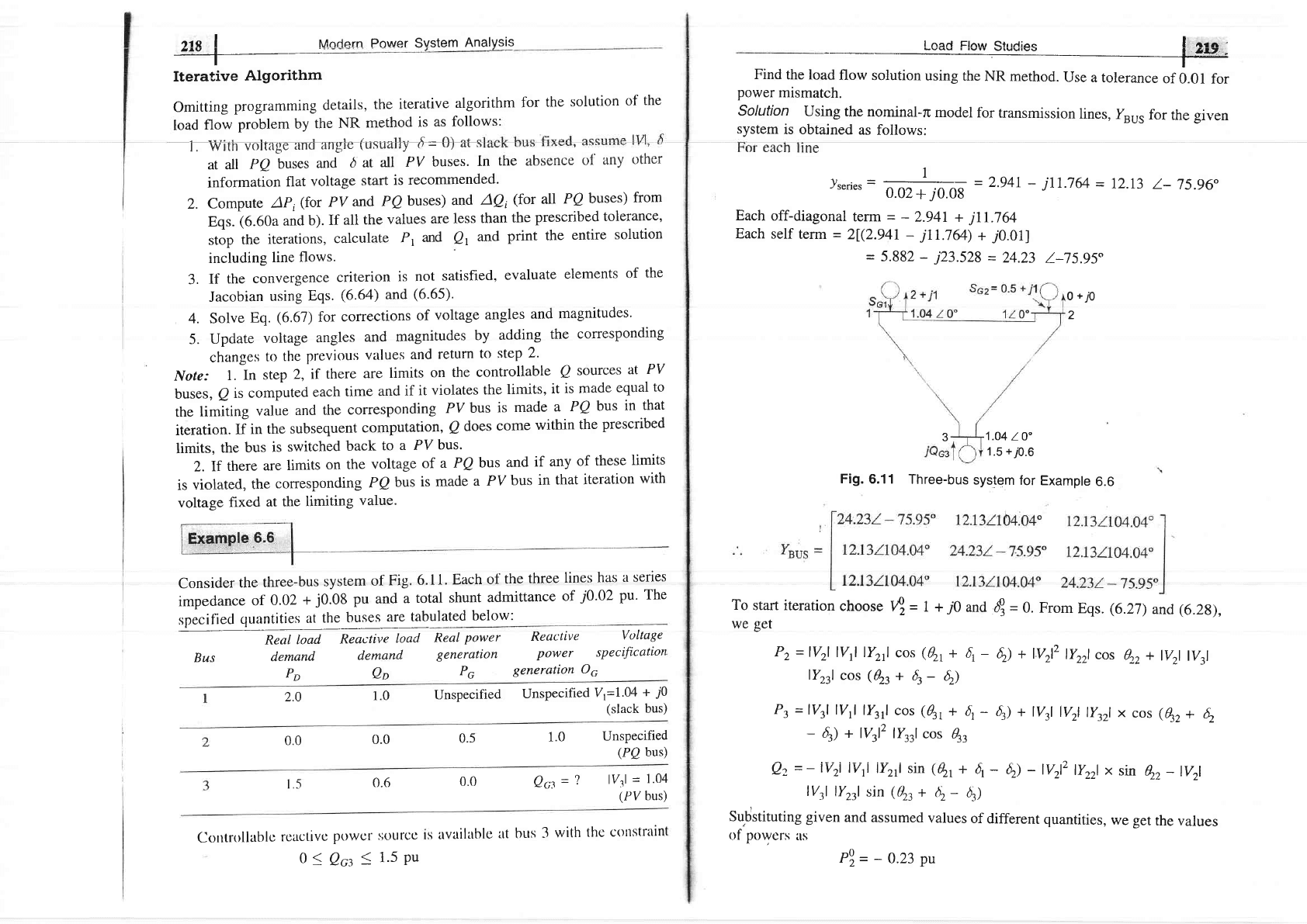
,re I rrrrodcrn Power Svstem
Analvsis
LLV
I
-T--
Iterative
Algorithm
Omitting
programming
details,
the
iterative
algorithm
fbr
the
solution
of
the
load
flow
problem
by
the
NR
method
is
as
follows:
L
W'ith
voittge
ancl
angle
(usually
f'=
€I) at
s
absence
of
anY
tlther
at atl
PQ
buses
and
d
at
all
PV
buses'
In
the
information
flat
voltage
start
is
recommended'
2.
Compute
AP,(for
PV
and
PB
buses)
and
AQ,(for
aII
PQ
buses)
from
Eqs.
(6.60a
and
b).
If
all
the
values
are
less
than
the
prescribed
toletance,
stop
the
iterations,
calculate
P,
and
Q,
and
print the
entire
solution
including
line
flows.
3.
If
the
convergence
criterion
is not
satisfied,
evaluate
elements
of
the
Jacobian
using
Eqs.
(6.64)
and
(6.65).
4. Solve
Eq.
(6.67)
for
corrections
of
voltage
angles
and
magnitudes'
5.
Update
voltage
angles
and
magnitudes
by
adding
the
corresponding
changes
to
the
previous
values
and
return
to
step
2'
Note:
1.
In step
2,
if
there
are
limits
on
the
controllable
B
sources
at PV
buses,
Q
is
computed
each
time
and
if
it violates
the
limits,
it
is made
equal
to
the
limiting
value
and
the
corresponding
PV
bus
is
made
a
PQ
bus
in that
iteration.
If
in
the
subsequent
computation,
Q
does
come
within
the
prescribed
limits,
the
bus
is
switched
back
to
a PV
bus.
2.
If
there
are
limits
on
the
voltage
of
a PQ
bus
and
if
any
of
these
limits
is
violated,
the
corresponding
Pp
bus
is
made
a PV
bus
in
that
iteration
with
voltage
fixed
at
the
limiting
value.
Consider
the
three-bus
system
of
Fig.
6.11.
Each
of
the
three
lines
has
a
series
impedance
of
0.02
+
1O.OS
pu
and
a
total
shunt
admittance
of
70'02
pu' The
specifiecl
quantities
at
the
_b"!91j9!qulated
below:
RealloadReactiveloadRealpowerReactiveVoltage
Lcad Ftor;
Studies
I i:ig,:
-
Find
the load
flow
solution
using
the
NR method.
Use
a tolerance
of
0.01 for
power
mismatch.
Solution
Using
the nominal-rc
model
for
transmission
lines,
I"u,
for
the given
system
is obtained
as follows:
eacn
ltne
1,sen."=
I
^
-z.g4r
-
j11.7&
-
r2.r3
l-75.96"
nes
o.oz+jo.og
Each
off-diagonal
term
=
-
2.94I
+
jll.764
Each
self
term
=
2l(2.941
-
j11.764)
+
j0.011
=
5.882
-
j23.528
=
24.23
l-75.95"
0
+,O
2
Fig.
6.11
Three-bus
system
for
Example
6.6
Pz
=
lVzl
lvl lY2l
cos
(0r1
+
6r
-
$)
+
lVrlz
lyrrl cos
0zz +
lvzl
l\l
lYrrl
cos
(Qzt+
q-
6)
Pt
=
lVl lvl
l\rl
cos
(dr,
+
6r
-
6r)
+
lVrl
lv2l
l\zl x
cos
(ez
+
h
-
6r) +
lV,rlz
lyrrl cos
0r,
Qz
=-ivzi
ivl
tyzl sin
(gr+
dt-
h)
-
lvzlz
ly22l
x
sn
4z_lv2l
lv3l
lY.,.l
sin
(0r,
+
bz
-
6)
Substituting given
and assumed
values
of
different
quantities,
we get
the values
trf
Powers
rts
PB.
=
-0.23
pu
To
start iteration
choose
4=
t +70
and
,4
=
0. From
Eqs.
(6.27)
and
(6.2g),
we
get
Bus
2.0
1.0
Unspecified
Unspecified
V'=1.94
*
;g
(slack
bus)
0.0
Unspecified
(PO
hus)
0.6 Qct=?
lvll
=
1.04
(PV
bus)
Controllablc
rcactivo
powor
sourcc
ls
availablc
nt btts
3
with
the
ctlnstraint
0<Qct
S
1.5Pu
demand
PD
demand
generation
power
specification
Qo
PG
generation
O6
0.0
1.0
0.5
0.0
l5
3
1.04
lO"
1.5
+7O.6
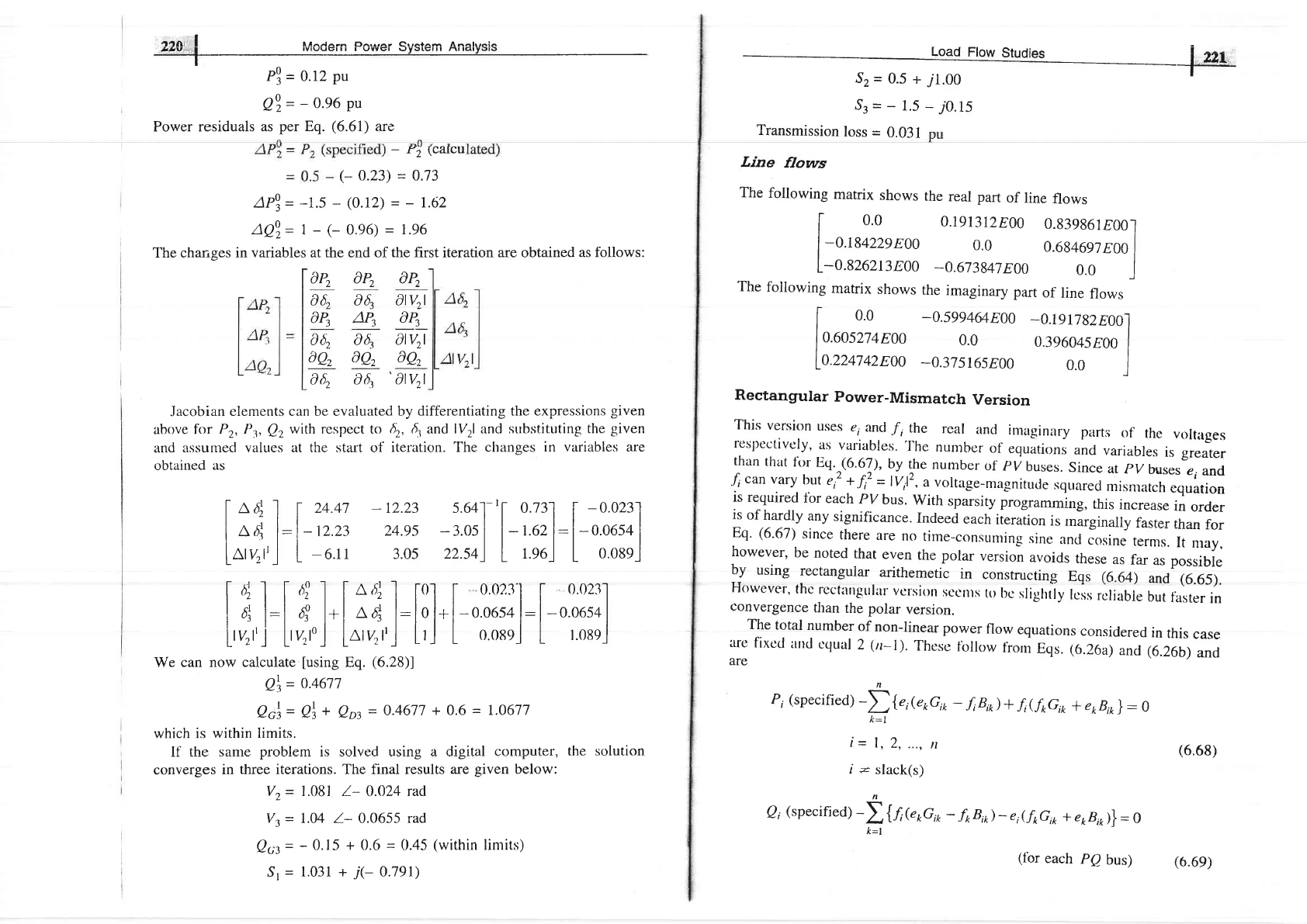
O}nr'l ilada-n Darrrar Crralam Anahraia
ttv.l
rvruuErrr r VYYEr
\)yolgltr
nrrqryoro
t
P3
=
0.12
pu
Qor=
-
0'96
Pu
Power
residuals as
per Eq.
(6.61)
are
-
rt (calcu
(-
0.23)
=
0.73
Aror-
-1.5 -
(0.12)
=
-
!.62
tQT=
1
-
(-
o'e6)
-
t'e6
The changes
in variables at the end of the first iteration are obtained
as follows:
0P, 0P, 0P,
06, 061 alv2l
0P,
aP, 7Pu
06, 061,
0lv2l
aQ, }Qz aQ,
06, 06:'
'av|
Jacobian
elements can be evaluated
by differentiating the expressions
given
above
fr>r
Pr, Py
Qz
with respectto
6r,
d1
and
lVrl and substituting
the
given
and
assumed values at the start of
iteraticln. The chanses
in variables are
obtained
as
Load
Ftow
Studies
i zzr
ti^--i.
Sz=0.5+j1.00
|
-
Sr=-1.5-j0.15
Transmission
loss
=
0.031
Line
flows
The
The
the
real
part
of
line
flows
0.1913r2E00
0.839861E'00-l
0.0
0.6s4697
E00
|
-0.673847
E00
0.0
J
the
imaginary
part
of
line
flows
-0.5994&E00
_0.r9178zE00]
0.0
0.39604s800
I
-0.37sr6s800
0.0
I
Rectangular
Power-Mismatch
Version
This
version
uses
e,
ancl
.f
,the
rear
ancr
imaginary
parts
of
the
v.ltages
resllectivcly,
as
variables'
'fhe
number
of
equations
and
variables
is greater
than
thart
tirr
Eq.
(6.6r),
by
the
nurnber
<tt
pi
buses.
Since
at
pv
buses
e,and
.f;
can
vary
but
,,'
+.f,'
-
lviP,
a
voltage-magnitude
squarecl
misn-latch
equation
is
required
tbr
each
PV
bus.
with
sparsity
programming,
this
increase
in
order
is
of
hardly
any
significance.
Indeed
each
iteration
is
rnarginally
faster
than
for
Eq'
(6'67)
since
there
are
no
time-consunring
sine
ancl
cosine
terms.
It
nray,
however,
be
noted
that
even
the polar
version
avoids
these
as
far
as possible
9f
using
rectangular
arirhemetic
in
constructing
Eqs (6.64)
and (6.65).
However'
thc
rcct:tttgtrlltr
vcrsion
sccnls
to
bc
slighiiy
t.r,
rcliable
but
faster
in
convergence
than
the polar
version.
The
total
number
of
non-linear
power
flow
equations
considered
in
this
case
arc
fixed
iurd
cqual
2
(trl).
These
lbllow
fr.o'i
Eqs.
(6.26a)
and (6.26b)
and
are
following
matrix
shows
I
oo
I-0.r8422eE00
L-0.826213^800
following
matrix
shows
I
o.o
I
l|0.60s274800
L0.224742E00
Itdjll-24.4i
-t2.23
s.64-1-r[0.i3f
[-0.023-1
| ^r I | .^^^ ^^-l | -^l | ^^.-.1
I
Aai
l:l-
t/..25 /.4.e)
-J.u)l
|
-
t.ozl:l-u.uo)4
|
[nrv,r'-]
L-uu
3.0s
zz.s4)
L
r.qol
I
ooarl
la)l Iai-l l-^4 I t-0.1 [
002.3
I [
0023.1
I
a]
l:l
I
l*l
^4
l:lol*l-006s41:l-006s41
Itv,t'j L'y,roJ lnrv.,r'.1
L'i I
oosoJ
I
r.08eJ
We
can now calculate
fusing
Eq.
(6.28)]
Qtt
=
0.a671
Qo\= Q\
+
Qrt
=
0.4677
+
0.6
=
1.0677
which is
within limits.
If' the
sanre
problem
is solved using a digital
computer,
the
solution
converges
in
three iterations. The final results are
given
below:
Vz=
1.081
l-
0.024
rad
Vt
=
I.M l- 0.0655 rad
Qu
=
-
0.I5
+
0.6
=
0.45
(within
linrits)
Sr
=
1.031 *
j(-
0.791)
P,
(specifi"d)
-I{
e,(epG11,
-
f,B,t)
+
fihrG*
-t
epB,o}
:
0
k:l
i
=
l,
2,
...,
n
i
=
slack(s)
n
rt.
B;
(specifi"d)
-)
lf,koG,o
-
ftB,t1-
e;(.f*Gi*
*
eoB,oy]}
=
g
k=l
(6.68)
(lbr
each
PQ
bus)
(6.69)
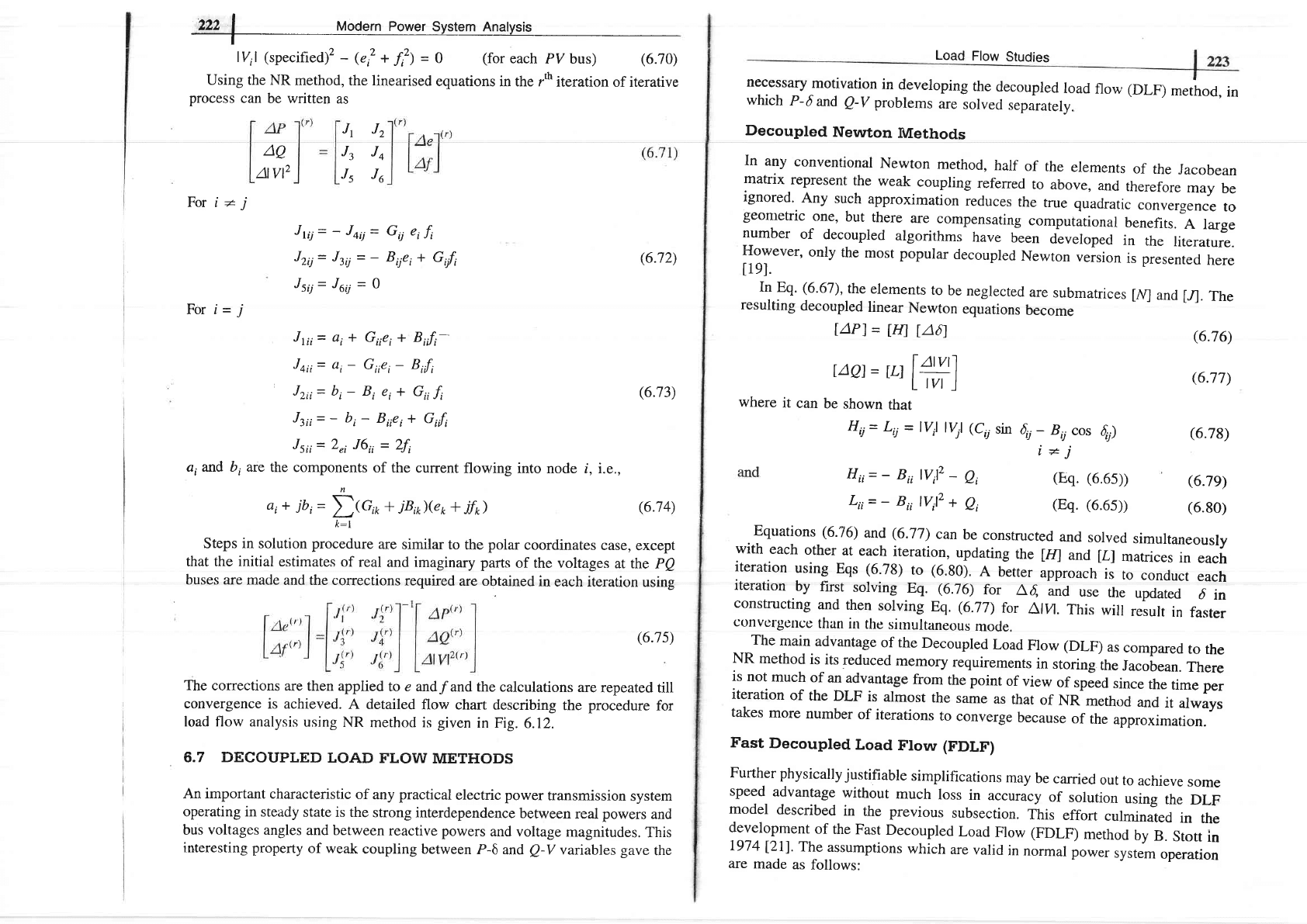
222
|
Modern
Porgl
Jyllem Anatysis
I
l(l
(specified)2
-
@i2
+
f,')
=
0
(for
each
PV bus)
(6.70)
Using the NR
method,
the linearised
equations
in the rft
iteration
of iterative
process
can
be written
as
Jr
J2
Load
Flow
Studies
necessary
motivation
in
developing
the
decoupled
load
flow (DLF)
method,
in
which
P-6
and
Q-V
problems
are
solvecl
separately.
Decoupled
Newton
Methods
For
i*
j
Juj=
-
Jqij
=
Gij ei
fi
Jzij=
Jt,j=-
Bijei+
Gilfi
6.72)
Jsij= Jo,j
=
O
For i=,r
t;^"'::: .-::::!-
tlr,,,
-!'
u,u-'
l,) i
J:,
Jsii=
2"i
J6ii
=
2fi
a, and b, are
the components
of the
current
flouring
into node i, i.e.,
a,+
jb,=
frCo
*
jBi)@r+
jf*)
k:l
(6.74)
Steps in solution procedure
are similar
to
the
polar
coordinates
case,
except
that the
initial
estimates
of
real and imaginary
parts
of
the voltages
at the
PQ
buses are
made
and the corrections
required
are obtained
in
each iteration
using
The
corrections
are then
applied
to e andf
and the
calculations
are
repeated
till
convergence
is achieved.
A
detailed
flow
chart describing
the
procedure
for
load flow analysis
using
NR
method is given
in Fig.
6.12.
FE FFAA'?hIEh 'AA
O. I L'|aUL,UTL|1L'
L('AL'
.F LL'VV IVI.EI.tsI(-,L'Ii
An important
characteristic
of
any
practical
electric
power
transmission
system
operating in
steady
state is the
strong
interdependence
between
real
powers
and
bus
voltages
angles
and between
reactive powers
and voltage
magnitudes.
This
interesting
property
of
weak
coupling
between
P-6
and
Q-V
variable.s
gave
the
In
any
conventional
Newton
method,
half
of
the
elements
of
the
Jacobean
matrix
represent
the
weak
coupling
referred
to
above,
and
therefore
may
be
ignored'
Any
such
approximation
reduces
the
true
quadratic
convergence
to
geometric
one,
but-there
are
compensating
computational
benents.i
large
number
of
decoupled
algorithms
have
been
dlveloped
in
the
literature.
However,
only
the
most
popular
decoupled
Newton
veision
is presented
here
t1el.
In
Eq.
(6.67),
the
elements
to
be
neglected
are
submatrices
[1v]
and
[,/].
The
resulting
decoupled
linear
Newton
equations
become
tApl
=
lHl
lA6l
I^Qt
-
tLt l4!1
Ltvt
J
where
it
can
be
shown
that
gU
=
Lij
=
lvil
lvjl
(CU
sin
AQ
AIVP
J3
J4
Js
J6
(6.73)
(6.7s)
Hii=
-
8,,lViP
-
Lii=
-
8,,
lV,lz
+
6u
-
B,i
cos
{r)
i*j
(Eq.
(6.6s))
(Eq.
(6.6s))
Qi
Qi
(6.76)
(6.77)
(6.78)
(6.7e)
(6.80)
Equations (6.76)
and
(6.77)
can
be
constructed
and
solved
simultaneously
with
each
other
at
each
iteration,
updating
the
[H]
and
[r]
matrices
in
each
iteration
using
Eqs
(6.78)
to
(6.80).
A
better
opproo.h
is
to
conduct
each
iteration
by
frst
solving
Eq.
(6.76)
for
44
*o
use
the
updared
6
in
constructing
and
then
solving
Eq.
(6.77)
for
Alvl.
This
will
result
in
faster
convcl'geuce
than
in
the
sirnultaneous
mode.
The
main
advantage
of the
Decoupred
Load
Flow
(DLF)
as
compared
to
the
NR
method
is
its
reduced
memory
requirements
in
storing
the
Jacotean.
There
is
not
much
of
an
advantage
from
the point
of
view
of
speed
since
the
time
per
iteration
of
the DLF
is
almost
the
same
as
that
of
NR
method
and
it
always
takes
more
number
of
iterations
to
converge
because
of
the
approximation.
Fast
Decoupled
Load
Flow
(FDLF)
Further
physically justifiable
simplifications
may
be
carried
out
to
achieve
some
speed
advantage
without
much
loss
in
accuracy
of
solution
using
the
DLF
model
described
in
the
previous
subsection.
This
effort
culminated
in
the
developmenr
of
the
Fast
Decoupled
Load
Frow (FDLF)
merhod
by
B.
stott
in
1974l2ll.
The
assumptions
which
are
valid
in
normal
power
ryr,"n1
operation
are
made
as
follows:
